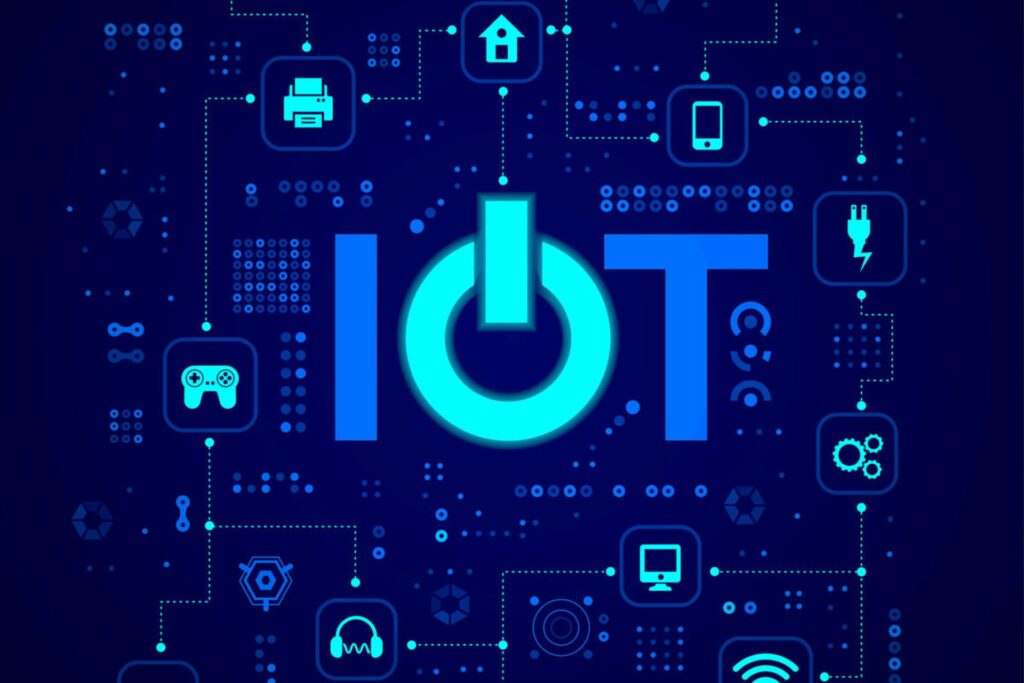
Introduction To IoT Devices
Your thermostat adjusting itself based on your schedule or your coffee maker brewing a fresh cup as soon as your alarm goes off - this is just the tip of the iceberg when it comes to Internet of Things (IoT) devices.
We live in a world where everyday items are becoming smarter because of Artificial Intelligence and are more connected than ever before thanks to IoT. Communities are embracing these cutting-edge technologies at an unprecedented rate. From smart thermostats to connected cars, IoT devices are revolutionizing the way we live and work. Yet, being able to regulate these gadgets has become critical for both individuals and businesses.
However, with great power comes great responsibility – understanding how to successfully manage these affiliated devices is critical for optimizing their potential while guaranteeing maximum security and efficiency.
So, strap up, and let's look at the essential techniques and best practices indicating How To Control IoT Devices. Along with that, you will get all the information you need to take command of this exciting technological frontier.
How To Control IoT Devices in 2024
So, you've got yourself a bunch of futuristic smart devices, but now what? It's all about owning the power of connectivity and ease when controlling these cool gadgets. By 2024, the methods for managing and monitoring Internet of Things devices are likely to go beyond mobile or web app integration. End users of consumer devices and operators of industrial IoT equipment today seek new ways to interact with linked devices.
Not only do we need to consider remote control techniques, but also the options for direct device engagement. They can also automate and control equipment, in addition to conventional buttons and touch screens, motion sensors, and sound sensors.
As a result, we can break down the question of How To Control IoT Devices into two main answers: ‘physical’ and ‘remote’.

How To Control IoT Devices | Physical Control Methods
Web of thing devices can be physically controlled via buttons, switches, sensors, and other components. They are found on the body of the device or on an external device that is wired or wirelessly attached.
The following are the most commonly used physical controls:
- Buttons on the Body
First of all, users can interact with the gadget directly using physical buttons built into the device. These buttons provide a direct link between the user and the gadget that allows simple operation. A smart home thermostat, for example, may incorporate physical buttons for temperature adjustments, helping you get rapid and tactile control.
- External Buttons
Separate from the device, external buttons enhance the physical control range. This externalization enables users to handle gadgets without making direct touch with them. This provides ultimate ease and adaptability. Further, in industrial settings, where devices are placed in hazardous environments, external buttons feed a safer and more accessible control.
- Switches on the Body
The device's integrated switches add to user-friendly control methods. These switches can control power states, modes, or particular operations, making the gadget more usable. A smart lighting system, for example, may have controls for switching between ambient and focused task illumination.
- External Switches
Similar to external buttons, external switches give an alternate method of physical control. Users can remotely change between settings or trigger actions, expanding the breadth of device administration. This is especially useful in situations when contacting the device directly is impractical.
- Touch Screens
Touch-screen IoT devices provide easy and dynamic control, empowering users to interact with sophistication. They are also used in consumer goods such as smart refrigerators so that people can browse through settings with a single touch.
- Touch Sensors
As opposed to screens, touch sensors detect touch gestures on specific areas of the device. This subtle yet effective strategy improves control accuracy. Further, touch sensors are frequently employed in wearables that help users interact with their gadgets via taps and swipes.
- Controllers for Gesture and Movement
Similarly, gesture and movement controller innovations enable people to interact with gadgets using natural motions. This hands-free technique provides a layer of convenience, whether by waving a hand or performing certain stirs. These controllers are also used in gaming consoles and smart TVs to provide an immersive and engaging encounter.
- Sound Sensors
Sound sensors, especially those that respond to clapping, provide an audio layer to control. Users may initiate tasks by using simple sound cues, giving an additional and accessible mode of engagement. This function is frequently included in smart home gadgets for users to control lights or appliances with a clap of their hands.
- Radio Remote Controls
Radiofrequency remote controllers enhance the physical control range. This strategy is beneficial when direct contact with the gadget is inoperable or dangerous. Additionally, radio remote controls in industrial automation enable personnel to handle machines from a safe distance, ultimately improving operational efficiency.
- Bluetooth Remote Controls
Remote controllers increase accessibility by utilizing Bluetooth technologies. People can manage devices remotely which gives them greater freedom in how they engage with IoT devices. Also, this is useful when physical closeness to the device is limited, such as when piloting a drone using a Bluetooth-enabled remote.
- RFID and NFC Tag Readers
RFID and NFC tag scanners provide smooth interaction by identifying tags if you are eager to know How To Control IoT Devices. This solution offers an extra degree of protection and personalization by enabling tailored device responses depending on detected tags. RFID readers in access control systems validate user IDs. This eventually increases the security of IoT-enabled doors or gates when integrated.
- Fingerprint Readers
Lastly, fingerprint readers, which are common in security applications, find relevance in smart device control. Users may verify themselves using fingerprint recognition, which adds an extra layer of user verification. This is especially important in situations when secure access to devices or sensitive information is paramount.

Remote Control Methods
The device architecture specified by the developers is the sole factor that determines whether the physical controls for an Internet of Things device are present. Since remote control techniques are defined at the IoT platform level, the user experience's completeness is determined by the platform selection. It is crucial to protect sensitive information.
- Mobile App
The first venture in How To Control IoT Devices is the Mobile App. Smartphones enable direct connection between IoT devices and themselves by functioning as universal controllers. The firmware on Internet of Things devices and the related platform software in the cloud is enhanced by the software created for mobile devices. Smartphones link to other devices directly or through a cloud connection. While direct Wi-Fi or Bluetooth connections provide instantaneous access, cloud-based control is a more effective solution. Here, the gadget uses the cloud as a storage repository in addition to a distant server on the internet to broadcast sensor data and receive user commands. Further, software that runs on the cloud plays a big part since it makes device business logic simpler and firmware reliability better.
Regardless of the connection method, mobile applications provide an intuitive user interface for smooth interaction with IoT devices. Users can access real-time device status data, evaluate historical sensor information, and practice control over the device state, including power management, mode switching, and configuration settings, including automation. Also, its user-friendly touch interface makes device operation more accessible to people of all ages and technical skill levels.
Security Perks
Furthermore, mobile applications particularly integrated with Machine Learning (like facial recognition) are critical in protecting the security of linked devices, which are vulnerable owing to persistent network access. These apps' authentication systems validate the user's identity before accessing the device. Mobile applications also make it easier to handle device firmware upgrades, ensuring that devices are running the most up-to-date software for increased functionality and security.
- Web Application
A web application, typically accessed via a browser, differs from a mobile app as it does not require any downloads or installs. It operates smoothly on any current browser, regardless of the operating system. Web apps are customary in industrial and medical IoT contexts to manage business device fleets, and assist system operators or administrators. These specialists use professional technologies for system health analysis to acquire real-time insights into thousands of devices.
Web apps flourish in these settings because a PC or laptop monitor can display more information than a smartphone screen. While we usually recognize them as professional tools, their potential in the consumer space is noteworthy. A web application for device control might be a more convenient alternative to a mobile application in some cases.
Moreover, in device management, sharing control via web apps is advantageous. Users may produce online application links, removing the requirement for receivers to install mobile apps or create accounts. This improves accessibility and makes online applications a viable alternative to mobile apps.
- Voice Assistants
And speaking of How To Control IoT Devices remotely, voice assistants are like having a virtual sidekick to help you manage your smart home empire. You can dim the lights, change the thermostat, and even start making your cup of joe with a single command - all without lifting a finger. (It's like living in a technologically advanced fairytale where everything falls into place with a magical voice-activated snap!) This is especially useful in situations when users must multitask or have restricted physical access to devices.
Because vocal communication is the most natural form for humans, it underpins the success of voice assistants such as Amazon's Alexa, Apple's Siri, and Google Assistant, as well as their local analogues. These virtual assistants can handle smart home ecosystems in addition to retrieving information and managing media content.
Integrating control with one or more of these existing voice assistants is the most prevalent choice among end users. Why? Because it provides a straightforward and effective method for utilizing advanced and functional solutions.
At the same time, the possibility of processing voice instructions directly on the device or through a separate IoT platform needs consideration. This, however, needs the addition of a microphone for recording voice commands and a speaker for giving aural feedback to the device. While viable, this method is more complex and costly, which in most cases does not make any sense.
- Automation Scenarios and Smart Home Systems
Configured by users or system administrators, automation scenarios provide a more efficient approach to operating IoT devices. These platforms and smart home systems prompt device reactions depending on specified triggers, allowing them to perform consistently in a variety of settings. For instance:
- Streetlights activate because of the light sensor readings or sunset in a specific region.
- Similarly, house lighting can turn on when there is some kind of motion or noise detected in a room.
- Furthermore, automated lawn watering starts when soil moisture sensors detect dryness, given a favourable weather forecast.
The beauty of automation lies in its low maintenance that requires only initial configuration. Once set up, the system works independently, enabling users to ignore its day-to-day operations. Users can customize alerts to handle non-standard or hazardous circumstances. Additionally, the technology alerts them immediately if there are any problems or possibly dangerous sensor readings, such as gas leaks or odd room temperatures. This assures ease as well as safety in the automatic functioning of IoT devices.
- Third-Party ServicesIntegration via API
The use of third-party services, such as Telegram messaging bots and IFTTT service catalogue connections, improves the administration and automation of IoT devices. APIs in these integrations facilitate interaction between different software products. Integration happens directly between the service and the IoT platform, which speeds up communication.
Intermediary services such as IFTTT offer control and automation between diverse software products that do not have intrinsic knowledge of one another. The adaptability of these connections opens up unforeseen possibilities. Users may manage gadgets based on Google Calendar events, such as pausing music during online meetings. Geolocation can trigger a gadget to be activated or deactivated. Furthermore, webhooks enable interaction with services outside the IFTTT directory, enabling multiple alternatives for personalized and dynamic control scenarios.
- SMS
Controlling gadgets using SMS is similar to controlling them via phone calls. Users can control the gadget by sending an SMS to a certain number (if the platform supports such integration). While this may appear to be out of date in today's setting, it remains relevant in some cases. For example, in areas with inconsistent mobile internet or a lack of Wi-Fi access, these methods prove practical and dependable.
- Phone calls
The Internet of Things predates phone call-based remote control, which was extensively used for gate or barrier controls requiring users to contact a specific number for access. Historically, controllers equipped with SIM cards simplified this procedure by deciding access depending on the caller's number. Modernizing this, online services now frequently replace physical controllers. The user's activity stays the same - dialling a particular number - but control improves through interaction with third-party services.
This advancement broadens control capabilities by allowing customers to remotely manage devices, toggle power, switch modes, and more with a simple phone call.
Finally, the last anchor in the dive of How To Control IoT Devices is email. Users may operate IoT devices via email, which is a less typical but conceivable integration. Users can smoothly adjust the device's working mode by sending mail to a preset address, giving another approach to the effective management of smart systems.
Ending Notes
The future of connectivity is waiting for us to grab hold of it! Because these smart gadgets are becoming more interwoven into our daily lives, it's crucial to stay ahead of the curve and understand how to control IoT devices. With a little knowledge and a lot of enthusiasm, anyone can easily manage their smart home or business environment.
As technology advances, so will our interactions with IoT devices. This ultimately anticipates that possibilities are endless!
Related Posts
From Turing to ChatGPT: What the History of NLP Teaches Us About the Business Applications of AI
Alan Turing first proposed his test of machine intelligence in 1950. He described an “imitation…
7 AI-Powered Apps on Mac for Small Businesses
If you own a small business it can be difficult to keep up with all…
Quantum Machine Learning | Connecting AI And Quantum Computing
Have you ever wondered if your future job might involve interacting with a device that…
Can Artificial Intelligence Replace Human Intelligence?
Imagine a world where AI brews your morning cup of joe before you even open…





Irena Robert
July 8, 2024Hi dear sir I am provide paid guest post sites, Are you interested If you have a marketing department or SEO agency, please forward this email to thema Are you looking to improve your website's authority? Are you looking to feature your brand at an affordable cost? If so, reach out to us. We have other blogs and can work with all budgets. My Email ID: [email protected] Thanks
Mark miller
July 8, 2024Hi Dear. My NAME is Mark Miller I am a professional marketer and provide Paid Guest Posting services. Nowadays, guest posts are a really important method to boost your SEO backlink + your business As you know, guest posts are one of the best ways to promote your product, or business through informative detailed articles, also with Do-follow backlinks. I have many sites and will provide you with backlinks to run your business smoothly. Reliable and trusted valued work here. Save your time and feel free to contact me. The email I'd: [email protected] Looking forward to your response. Thanks & Regards